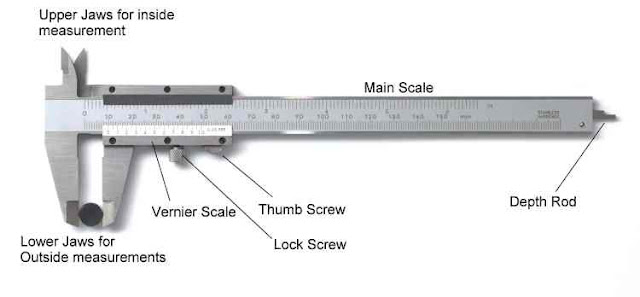Reamer and It's Types
Reamer:
A reamer is a rotating cutting implement
generally of cylindrical shape which is employed to enlarge and finish holes to
accurate dimensions to previously formed hole. It is usually equipped with two
or more peripheral grooves or flutes which may be parallel to axis (straight
reamers) or in a right or left-hand helix (fluted or spiral reamers). It is a
multiple edge cutting tool having the cutting edge on its periphery.
Parts of Reamer:
Following are the three main parts of Reamer:
1. Flute
2. Neck
3. Shank
The fluted part consists of chamfer,
starting taper, sizing section and back taper length. Chamfer length or bevel
lead insures proper and easy entry of the reamer into the hole. The main
cutting action of reamer is done by starting taper, the sizing section and to
guide the reamers and also smooth or size the hole. The back taper reduces
friction between reamers and the whole surface.
Types of Reamers:
Following are the common types of reamers:
1. Hand Reamer
2. Machine Reamer
3. Chucking Reamer
4. Fluting Reamer
5. Expanding Reamer
6. Adjustable Reamer
7. Tapered Reamer
8. Shell Reamer
These reamers are operated by hand with
a tap wrench fitted on the sequence of the reamer. The work is hold in a vice.
The flutes may be straight or helical. Shank is straight with a square tang for
the wrench.
2. Machine Reamer:
These are similar to hand reamer, except
that the shank is tapered. Machine reamers usually incorporate a chamfer of 45°
on the cutting end. These are used in turret lathes and screw machines. These
may be classed as fluted or rose type. Fluted reamers cut principally on the
chamfer and have radial clearance to very narrow margins of 0.2 to 0.4 mm in
width to assure free cutting.
3. Chucking Reamer:
These are machine reamers with shorter
flutes. These may be either of the type known as rose reamers or fluted
reamers. These are using for heavy roughing cuts.
There the holder are not rigid but are
fluting this permits the reamer. To flow the previously made hole naturally and
without restrained resulting in a better hole.
These reamers allow slight increase in
their size to allow for wear to remove an extra amount of material. For this
the body of the reamers is bored tapered and is slitted. A taper plug runs
through the hole end is operated by a screw so that it acts as the expander.
6. Adjustable Reamer:
In these reamers separate blades are
inserted within the grooves provided within the body of the reamer. The blades
are often moved up or down of the reamer.
7. Tapered Reamer:
These reamers are used to finish the
taper holes for cutting the taper things accustomed secure the collars, pulleys
etc to the shaft.
8. Shell Reamer:
Solid reamers (upto about 20mm diameter
or usually manufactured from HSS) to scale back the value of larger reamers the
cutting portion is formed as separate shell which are mounted on standard
shanks made of lower cost steel. These reamers are however don't very rigid and
accurate inserted tooth or plates in shells in further reduced the value of
reamers can tip with cemented carbides.











Comments
Post a Comment